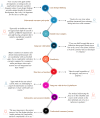Usability Challenges for Health and Wellness Mobile Apps: Mixed-Methods Study Among mHealth Experts and Consumers
- PMID: 30698528
- PMCID: PMC6372932
- DOI: 10.2196/12160
Usability Challenges for Health and Wellness Mobile Apps: Mixed-Methods Study Among mHealth Experts and Consumers
Abstract
Background: By 2019, there will be an estimated 4.68 billion mobile phone users globally. This increase comes with an unprecedented proliferation in mobile apps, a plug-and-play product positioned to improve lives in innumerable ways. Within this landscape, medical apps will see a 41% compounded annual growth rate between 2015 and 2020, but paradoxically, prevailing evidence indicates declining downloads of such apps and decreasing "stickiness" with the intended end users.
Objective: As usability is a prerequisite for success of health and wellness mobile apps, this paper aims to provide insights and suggestions for improving usability experience of the mobile health (mHealth) app by exploring the degree of alignment between mHealth insiders and consumers.
Methods: Usability-related major themes were selected from over 20 mHealth app development studies. The list of themes, grouped into 5 categories using the Nielsen usability model, was then used as a framework to identify and classify the responses from mHealth expert (insider) interviews. Responses from the qualitative phase were integrated into some questions for a quantitative consumer survey. Subsequently, categorical data from qualitative mHealth insider interviews and numerical data from a quantitative consumer survey were compared in order to identify common usability themes and areas of divergence.
Results: Of the 5 usability attributes described in Nielsen model, Satisfaction ranked as the top attribute for both mHealth insiders and consumers. Satisfaction refers to user likability, comfort, and pleasure. The consumer survey yielded 451 responses. Out of 9 mHealth insiders' top concerns, 5 were similar to those of the consumers. On the other hand, consumers did not grade themes such as Intuitiveness as important, which was deemed vital by mHealth insiders. Other concerns of the consumers include in-app charges and advertisements.
Conclusions: This study supports and contributes to the existing pool of mixed-research studies. Strengthening the connectivity between suppliers and users (through the designed research tool) will help increase uptake of mHealth apps. In a holistic manner, this will have a positive overall outcome for the mHealth app ecosystem.
Keywords: health and wellness mobile applications; health and wellness mobile applications insiders; health and wellness mobile applications users; mHealth apps; mHealth insiders; mHealth users; mobile applications.
©Mei Shan Liew, Jian Zhang, Jovis See, Yen Leng Ong. Originally published in JMIR Mhealth and Uhealth (http://mhealth.jmir.org), 30.01.2019.
Conflict of interest statement
Conflicts of Interest: None declared.
Figures













References
-
- Heisler Y. BGR. 2016. [2018-08-16]. Mobile internet usage surpasses desktop usage for the first time in history https://bgr.com/2016/11/02/internet-usage-desktop-vs-mobile/
-
- Statista. 2016. Number of smartphone users worldwide from 2014 to 2020 (in billions) https://www.statista.com/statistics/330695/number-of-smartphone-users-wo...
-
- Research 2 Guidance. [2019-01-22]. The mHealth app market is getting crowded reaching the 259,000 apps https://research2guidance.com/mhealth-app-market-getting-crowded-259000-...
-
- Huckvale K, Car M, Morrison C, Car J. Apps for asthma self-management: a systematic assessment of content and tools. BMC Med. 2012;10:144. doi: 10.1186/1741-7015-10-144. http://www.biomedcentral.com/1741-7015/10/144 1741-7015-10-144 - DOI - PMC - PubMed
MeSH terms
LinkOut - more resources
Full Text Sources
Medical
Research Materials

